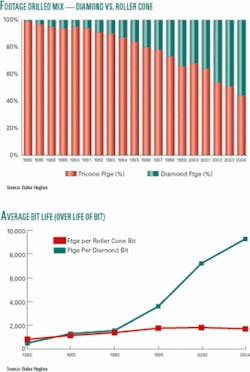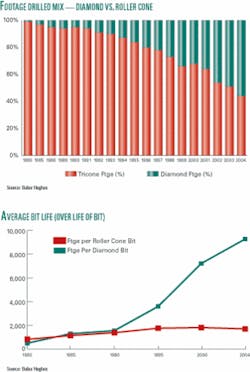Throughout the history of drilling, “Heavy Metal” (not to be confused with the music genre) has been the preferred cutting element for grinding/crushing/chipping formations on literally the leading edge of a drilling device. The Chinese used heavy metal of sorts in percussion drilling (still a very popular method of drilling for water) in 1100 BC. In the beginning, most oil wells were created using percussion drills. In the 19th and 20th centuries, improvements in steel technology produced rotating drill bits that could quickly cut through soft rocks.
Even in soft rocks, steel can wear down very rapidly, so it was often covered with inserts or a complete outside layer of tungsten carbide, which is more brittle than steel, but has greater resistance to erosion. After the invention of the original Hughes roller cone bit in 1909, there were major improvements in hard facing which resulted in increased longevity for the bits using open bearings. Then came o-rings, grease-sealed bearings, the first tungsten carbide bit in 1951and later journal bearings. All during this time, roller cones were the default bit of the drilling industry.
Diamonds Emerge as a Cutting Element
Though not as heralded, a new cutting element emerged in 1910 when geologists first used natural diamonds for drilling. Hollow “coring” bits were used to cut doughnut-shaped holes and retrieve columns of rock for analysis, mostly for mineral exploration. In this application, the use of diamonds as a drilling/cutting element was born. Not many years after this introduction, it became obvious diamond drilling technology offered much potential in the oilfield.
As the hardest material known to man, diamond is 10 times harder than steel, 2 times harder and 10 times more wear-resistant than tungsten carbide. It has 20 times the compressive strength of granite. The application of diamonds to oilfield drilling was inevitable. Although there were earlier prototype versions, full-hole diamond drilling bits were first commercially introduced to the industry in the early 1950s. The bits used natural diamonds comprised of industrial-grade stones crushed and processed to specific sizes and regular, rounded shapes. Because diamonds form deep in the earth under intense heat and extreme pressure for thousands of years, they were particularly useful in hard rock drilling applications.
In the early 1970s, diamond technology reached a major milestone when General Electric developed a process to make synthetic diamonds. Thin circular layers of alternating carbon graphite and cobalt were stacked in small cans under high pressures and temperatures. This ultimately led to the development of a polycrystalline diamond compact (PDC) cutting element where synthetic diamond grit feed stock is mixed with cobalt as a catalyst in a HT/HP press that fuses them together for a diamond-to-diamond bond. The product was quickly adapted for oilfield drilling in the form of a “fixed cutter” bit. PDCs subsequently opened a whole new application range for diamond bits. Materials, design and manufacturing processes continue to be improved and perfected.
PDCs Undergo a Step Change in Performance
In the last few years the quality and types of PDC cutters have improved dramatically. If you compare the cutters of the 1980s to today’s cutters, there’s a magnitude of difference. Their quality properties are better because of changes in the mix and manufacturing processes, making the bit much more abrasion and impact resistant.
Engineers have also optimized the interface between the tungsten carbide substrate and the synthetic diamond to improve cutter toughness. Innovations in layered diamond technology have been applied to provide greater abrasion resistance and thermal stability. In short, a lot of things learned over time have improved the product and the advances are still coming.
Besides material and manufacturing advancements, PDCs have made a major breakthrough in cutter design technology and placement. They can now be used in areas where they couldn’t before like harder, more abrasive and variable formations. The transition into new applications has affected the whole balance of diamond (fixed cutter) vs. roller cone usage.
Originally, PDCs were used in soft shale because a hard stringer would destroy the bit. Due to the new technology and design changes, PDCs can now drill through these hard stringers and long sections of fairly hard rock. They are becoming more and more the bit of choice, especially as cutters have gotten better and better.
The steerability of PDCs has also improved due to design and cutter innovations, further eroding the old advantage of roller cones in motor applications. It’s a simple fact. PDCs are supplanting roller cones in many formation applications on a daily basis.
Parity and Beyond in Bit Types
Since the introduction of diamond bits to the industry almost a century ago, the total footage drilled with either natural or synthetic diamonds has grown steadily and is now at parity with roller cone bits. Although estimates vary, Security DBS says in 2003, the split of footage drilled was 60% roller cone and 40% fixed cutter. The Hard Rock transition (replacement of roller cone insert bits with PDC), however, has seen a major shift in this split. The company now expects the ultimate share of fixed cutter bits may reach 60% by 2008. Roller cone revenues for Security DBS are projected to remain at current levels, but the bits will continue to play a vital role in drilling throughout the world. No matter whether it’s a roller cone or diamond bit, ROP, bit cost, hole quality, durability and steerability comparisons will always be made on both types.
The accompanying charts show the gradual displacement of roller cone bits with diamond bits for almost 25 years. Figure 1 tracks the Footage Drilled Mix of Diamond vs. Roller Cone bits. Figure 2 shows how Average Bit Life (footage drilled) has also swung heavily towards diamonds.
Diamond bit footage (over the life of a bit) took off rapidly in 1995 due to the growing rental/repair of PDCs. Roller cone footage drops in 2004 because softer, longer runs with roller cones were taken over by PDCs, leaving roller cones to drill harder formations more likely to produce shorter runs.
Early natural diamond bits were used in drilling hard abrasive rock at 3-4 ft/hr by grinding, whereas PDC bits actually shear the rock. With the changes and improvements in PDC bits, they are replacing the type Five roller bits. On a footage basis, there are still many roller cones used because they don’t drill as many feet per unit. Still, it’s obvious that half of the rocks are now being drilled with diamond bits. Just as obvious are the applications where roller cone cutting action is still superior to the shearing of PDCs.
A Further Diamond Split
It’s interesting to note the diamond segment of the bit market has also split. In the 1980s, PDC bits were a smaller part of the diamond business than natural diamonds. As noted, however, they have come into their own and increased the amount of footage per run. Strong performance recently has led to the concept of rental and/or repairing of the PDC bit so that more footage on average per unit can be generated. In particular, within the last two years the PDC bit business in the US and Canada has exploded. The bits last so long that they can be rented and then repaired and run again. It’s not uncommon to now drill 8-9,000 ft with one bit. There are recent reports that 75% of the footage in the Rocky Mountains is now drilled with PDCs.


